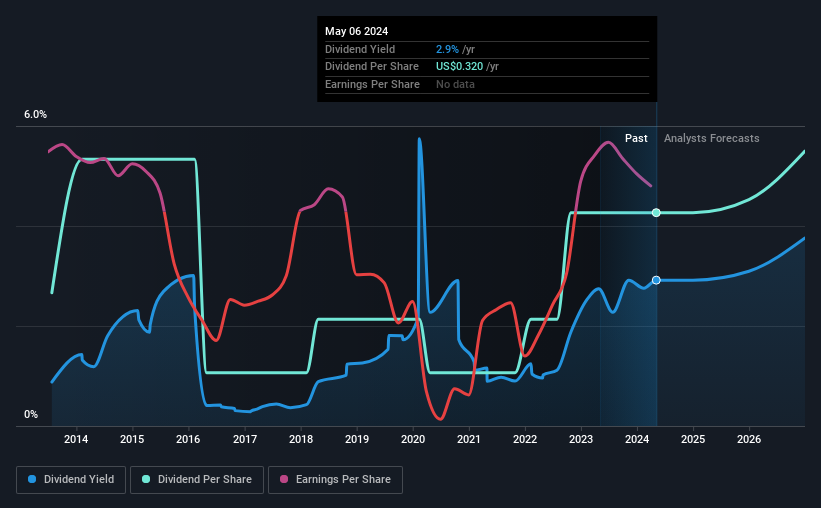Patterson-UTI Energy (NASDAQ:PTEN) Has Affirmed Its Dividend Of $0.08
Patterson-UTI Energy, Inc. (NASDAQ:PTEN) will pay a dividend of $0.08 on the 17th of June. The dividend yield will be 2.9% based on this payment which is still above the industry average.
See our latest analysis for Patterson-UTI Energy
Patterson-UTI Energy's Dividend Is Well Covered By Earnings
While it is great to have a strong dividend yield, we should also consider whether the payment is sustainable. Based on the last payment, Patterson-UTI Energy was quite comfortably earning enough to cover the dividend. This indicates that quite a large proportion of earnings is being invested back into the business.
The next year is set to see EPS grow by 197.2%. If the dividend continues on this path, the payout ratio could be 21% by next year, which we think can be pretty sustainable going forward.
Dividend Volatility
The company's dividend history has been marked by instability, with at least one cut in the last 10 years. Since 2014, the dividend has gone from $0.20 total annually to $0.32. This works out to be a compound annual growth rate (CAGR) of approximately 4.8% a year over that time. We're glad to see the dividend has risen, but with a limited rate of growth and fluctuations in the payments the total shareholder return may be limited.
The Dividend Looks Likely To Grow
Growing earnings per share could be a mitigating factor when considering the past fluctuations in the dividend. Patterson-UTI Energy has seen EPS rising for the last five years, at 40% per annum. The company's earnings per share has grown rapidly in recent years, and it has a good balance between reinvesting and paying dividends to shareholders, so we think that Patterson-UTI Energy could prove to be a strong dividend payer.
We should note that Patterson-UTI Energy has issued stock equal to 94% of shares outstanding. Trying to grow the dividend when issuing new shares reminds us of the ancient Greek tale of Sisyphus - perpetually pushing a boulder uphill. Companies that consistently issue new shares are often suboptimal from a dividend perspective.
We Really Like Patterson-UTI Energy's Dividend
Overall, we think that this is a great income investment, and we think that maintaining the dividend this year may have been a conservative choice. Distributions are quite easily covered by earnings, which are also being converted to cash flows. Taking this all into consideration, this looks like it could be a good dividend opportunity.
Market movements attest to how highly valued a consistent dividend policy is compared to one which is more unpredictable. Meanwhile, despite the importance of dividend payments, they are not the only factors our readers should know when assessing a company. For example, we've identified 5 warning signs for Patterson-UTI Energy (1 is a bit unpleasant!) that you should be aware of before investing. If you are a dividend investor, you might also want to look at our curated list of high yield dividend stocks.
Have feedback on this article? Concerned about the content? Get in touch with us directly. Alternatively, email editorial-team (at) simplywallst.com.
This article by Simply Wall St is general in nature. We provide commentary based on historical data and analyst forecasts only using an unbiased methodology and our articles are not intended to be financial advice. It does not constitute a recommendation to buy or sell any stock, and does not take account of your objectives, or your financial situation. We aim to bring you long-term focused analysis driven by fundamental data. Note that our analysis may not factor in the latest price-sensitive company announcements or qualitative material. Simply Wall St has no position in any stocks mentioned.

 Yahoo Finance
Yahoo Finance 
